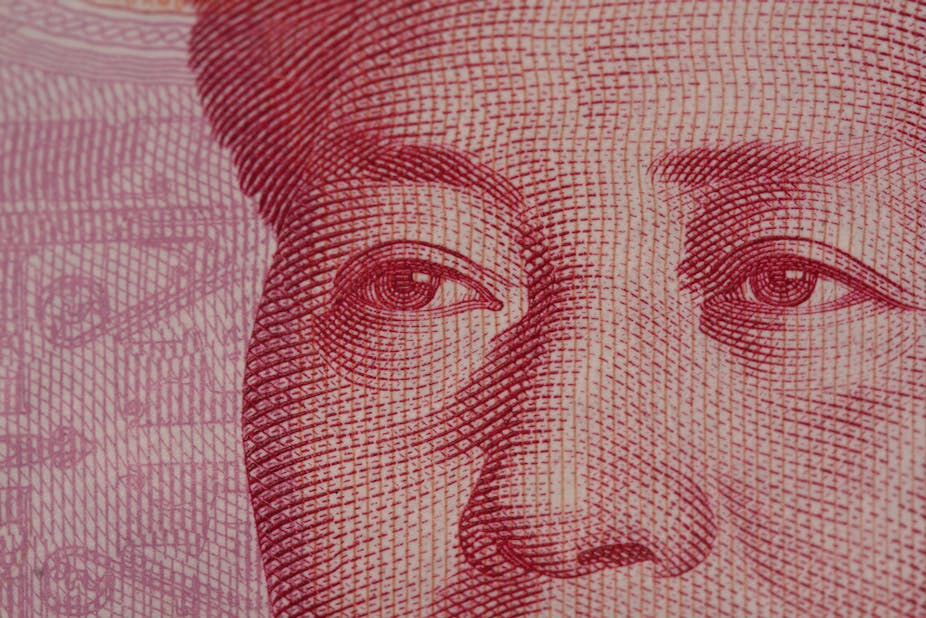Australia’s free trade deal with China will invariably boost bilateral trade and investment. But how trade and investment are settled also matters. Given the rise of the renminbi (RMB) in recent years, the China FTA will further add momentum to the RMB going global, and Australia is well positioned to ride the wave.
Since 2009, Beijing has been deploying its resources strategically on a campaign to lift the RMB’s global clout in both trade and financial terms. According to data from SWIFT, the RMB strengthened its position as the seventh-ranked global payments currency and the second-most-used currency for trade financing by October 2014. In September 2014, the value of RMB global payments increased by 13.2%, well above the average 8.1% growth for all currencies.
But there is still huge potential for the RMB in global transactions given China’s share in world trade. Today the RMB accounts for less than 2% of global payments.
Huge potential for Australia
The Australian government has rightly identified the strategic importance of the Chinese currency. The Reserve Bank of Australia (RBA) signed a bilateral currency swap agreement with its Chinese counterpart, the People’s Bank of China (PBoC), in March 2012.
The agreement allows exchange of local currencies of up to A$30 billion (RMB 200 billion). The deal is the largest that China has signed other than those with Hong Kong and South Korea. It is also one of the first with a Western economy.
In April 2013 Australia and China began direct conversion between the yuan and Australian dollar (instead of using the US dollar as medium). That makes Australia the third country after the United States and Japan to have its currency directly converted to the RMB.
Some 5% of Australia’s foreign currency reserves is already parked in RMB-denominated Chinese government bonds. This means the RBA is joining a small but growing band of central banks that have looked to China to diversify their foreign reserves. Australia is also among the top five countries in the world using RMB for trade finance.
Nevertheless, the use of RMB in settlement is still relatively limited in Australia’s bilateral trade with China. In February 2014, for example, 14.2% of payments between Australia and China/Hong Kong were in RMB, but as the SWIFT data indicates, 98% of these payments in value were institutional, as opposed to payments sent by banks on behalf of their customers.
This suggests RMB has been mainly used for investments and foreign exchange activities, rather than trade settlement. In fact, currently only 4% of settlements in China are in RMB (and only 1% of those involving an Australian counterpart). The Chinese government plans to increase this proportion to 15% by 2015.
The FTA
This is where the free trade agreement kicks in. An enlarged scale of bilateral trade will most likely increase the propensity of Australian organisations to invoice, settle and finance trade with China in RMB. At the same time, China has rolled out a series of complementary measures to facilitate the use of the RMB in trade and investment.
First, the RBA and the PBoC have agreed to establish an official RMB trading hub in Sydney. The latter will announce the designated clearing bank shortly. This clearing arrangement, in addition to the settlement services provided by the ASX and the Bank of China, will provide an operational platform for Australian importers and exporters to carry out more direct trading with their Chinese counterparts in RMB.
It means more efficient and rapid settlement of RMB payments, savings on invoicing costs, reduction of exchange-rate risk and reach to more Chinese customers and investors who prefer to trade in their currency. Sydney could be joining Hong Kong, Singapore and London as a global offshore RMB centre.
At the same time, China has sought to increase the attractiveness of the RMB through financial opening and diversifying investment channels for offshore RMB deposits, so that foreign entities can get decent returns on their RMB holdings.
New liberalisation
What is notable on this front is that, on the same day as the FTA announcement, a cross-border investment channel was established that could mark the beginning of the end of China’s decades-long capital control.
The Shanghai-Hong Kong Stock Connect is a pilot program that for the first time links foreign investors with China’s vast domestic stock market without individual approval. Previously, foreign investors could only participate indirectly in China’s securities markets through certain investment fund products.
With the launch of Stock Connect, investors will be able to trade eligible Shanghai-listed A-shares directly. This could well be a milestone of financial liberalisation in China.
All trades under the program will be done in RMB. The expected outflow of RMB from mainland China and inflow from overseas (through Hong Kong) will establish a healthy ecosystem for the Chinese currency. It will also expand and diversify investment channels for overseas RMB holdings, helping to further facilitate its internationalisation.

